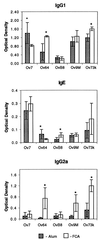Development of a recombinant antigen vaccine against infection with the filarial worm Onchocerca volvulus
- PMID: 11119514
- PMCID: PMC97880
- DOI: 10.1128/IAI.69.1.262-270.2001
Development of a recombinant antigen vaccine against infection with the filarial worm Onchocerca volvulus
Abstract
Efforts to control Onchocerca volvulus, the etiologic agent of river blindness, have been limited to vector control and drug treatment to eliminate microfilariae, with no means available to prevent infection. The goal of this study was to develop a vaccine against this infection using recombinant antigens that are expressed in the early larval stages of the parasite. Five recombinant antigens, Ov7, Ov64, OvB8, Ov9M, and Ov73k, were identified by screening adult and larval cDNA libraries with antibodies from immune humans, chimpanzees, or rabbits. When mice were immunized with the five individual recombinant antigens, statistically significant reductions in parasite survival were induced in mice immunized with Ov7, OvB8, or Ov64, when administered in alum but not when injected in Freund's complete adjuvant (FCA). Live larvae recovered from control and immunized mice were analyzed to determine their developmental stages. A decrease in the percentage of larvae molting from the third stage to the fourth stage was observed with mice immunized with Ov7, Ov64, or OvB8 in alum but not with mice immunized with Ov9 and Ov73k or with mice immunized with any of the five antigens in FCA. Mice immunized with a cocktail of the three protective antigens developed protective immunity equal to that seen with mice immunized with individual antigens. This study has identified, for the first time, three recombinant antigens capable of inducing protective immunity to O. volvulus. Furthermore, since the antigens functioned with alum as the adjuvant, this vaccine could potentially be used clinically to prevent river blindness in humans.
Figures




References
-
- Abraham D, Grieve R B. Genetic control of murine immune responses to larval Dirofilaria immitis. J Parasitol. 1990;76:523–528. - PubMed
-
- Abraham D, Grieve R B. Passive transfer of protective immunity to larval Dirofilaria immitis from dogs to BALB/c mice. J Parasitol. 1991;77:254–257. - PubMed
-
- Abraham D, Grieve R B, Holy J M, Christensen B M. Immunity to larval Brugia malayi in BALB/c mice: protective immunity and inhibition of larval development. Am J Trop Med Hyg. 1989;40:598–604. - PubMed
-
- Abraham D, Grieve R B, Mika-Grieve M. Dirofilaria immitis: surface properties of third- and fourth-stage larvae. Exp Parasitol. 1988;65:157–167. - PubMed
-
- Abraham D, Grieve R B, Mika-Grieve M, Seibert B P. Active and passive immunization of mice against larval Dirofilaria immitis. J Parasitol. 1988;74:275–282. - PubMed
Publication types
MeSH terms
Substances
Grants and funding
LinkOut - more resources
Full Text Sources
Other Literature Sources

